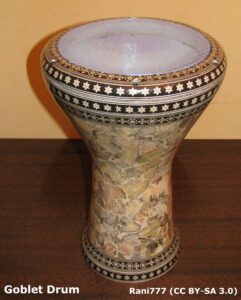Introduction
Let’s go down the rhythm rabbit hole! The rhythmic mode or iqa/iqaat (plural) is a foundational feature of Middle Eastern music. Songs in the Middle East have repeated sequences of strong and weak drum beats. These are the iqaat, and there are reputedly up to 100 of them (Wikipedia: “Rhythm in Arabic Music”).
In this post, you will learn seven iqaat commonly found in Middle Eastern belly dance music. This should help you recognise the rhythms as you dance to belly dance music. I’ll start by building up the basics of what are Middle Eastern drum strokes. Then I’ll introduce rhythmic notation, and then put them together into different iqaat.
Why is it important to recognise iqaat in the music you’re dancing to? A particular iqa gives the music a particular feeling. Being able to recognise the iqa and how it feels for you, either intuitively or by putting a name to it, gives you an additional string in your dancing bow. The particular rhythmic feel may evoke certain movement qualities in your dance. And when the iqa changes in a song, your dancing should too. Depending on how the new iqa makes you feel compared to the old.
Introduction
Rhythm Basics
Maqsoum
Saiidi
Masmoudi Saghir (Baladi)
Fellahi
Masmoudi Kabir
Malfuf
Chiftetelli
Resources
Rhythm Basics

Middle Eastern rhythms are commonly played on a goblet drum: called a tabla, darbuka, or doumbek.
There are two primary strokes on a goblet drum which are played with your dominant hand: a dum and a tak. The dum is a lower-pitched sound produced by striking the centre of the drum head. The tak is a higher-pitched sound produced by striking the edge of the drum head. A ka is a tak played with the non-dominant hand. (Wikipedia: “Goblet Drum”) Here’s a YouTube video demonstrating the basic drum strokes:
Let’s move onto the rhythmic notation of the iqaat. I’ve notated their skeletal structures in ‘American Creole’ notation (Baba Yaga Music: “Middle Eastern and Mediterranean Dance Rhythm Diagrams and Descriptions”). This breaks each bar down into beats and sub-beats and puts dums (D), taks (T), and kas (K) in the appropriate position. A rest (no sound) is indicated by a period (.). The counting of beats within a bar is broken down with ‘1e&a’ notation:
(1) A note that begins on the beat is called by the number of the beat.
Counting 1e&a
(2) A note that begins halfway between two beats is called ‘&’ (pronounced and).
(3) A note that begins on the second quarter of the beat is called ‘e’ (pronounced ee).
(4) A note that begins on the fourth quarter of the beat is called ‘a’ (pronounced uh)
I’ve also included a YouTube video for each iqa. It gives the skeletal rhythm, a variation or two, and a demonstration of the ornamented iqa. Listen carefully to the ornamented iqa especially. Try to hear the skeletal rhythm underneath.
These notated structures are only the bare bones of the iqaat. In reality, a skilled musician will create unique variations with fills, ornaments, and flourishes. The ornaments fill in the skeletal structure to give an iqa a rich and infinite variety. The emphasis and feel of an iqa will distinguish it to a practised ear more so than the rhythmic structure (Baba Yaga Music: “Middle Eastern and Mediterranean Dance Rhythm Diagrams and Descriptions”).
Maqsoum
The most common iqa in belly dance music is the maqsoum. It has four beats to a bar. It has a steady rhythm marked by the dums on the 1st and 3rd beats. For me, it feels like a ‘walking rhythm’ – one that can go on and on at a steady pace. It’s very versatile and accessible for dancers. You’ll find it as the main iqa in all sorts of Middle Eastern songs, from pop to ‘golden era’ classics and beyond.
1 e & a 2 e & a 3 e & a 4 e & a D . T . . . T . D . . . T . . .
Saiidi
The saiidi iqa is related to the maqsoum. The dum instead of the tak on the ‘&’ of the second beat differentiates its skeletal structure from the maqsoum. Despite it’s similarity, it has a different feeling. The extra dum in the middle makes it heavier and more grounded. For me, I really feel the middle dums sinking into the ground. It’s commonly used in saiidi style (cane) dance, as well as for sections of ‘regular’ belly dance songs.
1 e & a 2 e & a 3 e & a 4 e & a D . T . . . D . D . . . T . . .
Masmoudi Saghir (Baladi)
Another relative of the maqsoum (sensing a pattern here?) is the masmoudi saghir or baladi iqa. It has a dum-dum on the ‘1&’ instead of a dum-tak as in the maqsoum. This gives it an extra weight to the first beat, unlike the saiidi where the heaviness is in the middle of the bar. I feel the two dums at the beginning as a spring compressing down. It bounces back up as the ornamentation fills in the rest of the bar. It’s a common one in the belly dance song repertoire, and can frequently be found in the same song as the maqsoum.
1 e & a 2 e & a 3 e & a 4 e & a D . D . . . T . D . . . T . . .
Fellahi
The fellahi has a fast rhythm; it has two beats to a bar instead of four. It’s like a maqsoum (again) compressed into two beats instead of four. The dums on one and two give it quite a steady feel despite its usually rapid pace. What makes it a fellahi for me is hearing the rhythm repeat every 2 beats and the steady 1-2 dums with a lot of embellishment in between. Fellahi is sometimes found as an entrance and often as the finale to a piece of belly dance music.
1 e & a 2 e & a D T . T D . T .
Masmoudi Kabir
The masmoudi kabir (‘big masmoudi’) is the masmoudi saghir (‘small masmoudi’) stretched out to eight beats to a bar instead of four. It also has an extra tak at the end. In addition, I’ve presented a very common variation below (the ‘three dum masmoudi’) which has a third dum at the beginning. I hear the dum dum … dum pattern quite clearly in the iqa. Masmoudi kabir can be found in a lot of big and juicy ‘golden era’ classics as well as other lyrical songs.
1 e & a 2 e & a 3 e & a 4 e & a 5 e & a 6 e & a 7 e & a 8 e & a D . . . D . . . . . . . T . . . D . . . . . . . T . . . T . . .
Three dum masmoudi variation:
1 e & a 2 e & a 3 e & a 4 e & a 5 e & a 6 e & a 7 e & a 8 e & a D . . . D . . . D . . . T . . . D . . . . . . . T . . . T . . .
Malfuf
Back to two beats to the bar. Malfuf is an iqa in two beats which is characterised by a dum on one and two off beat taks. It has typical rolling embellishments between the taks. For me, the rapid dum tak tak, dum tak tak, dum tak tak gives it a sense of urgency and motion. This driving rhythm is a typical entrance iqa for a belly dance song.
1 e & a 2 e & a D . . T . . T .
Chiftetelli
Our last iqa is the chiftetelli, which has a slow, strong rhythm with eight beats to a bar. I hear the dum-dum-tak on beats five, six, and seven quite strongly in this iqa. It tends to have a lot of space in between the drum beats, making it suitable for melodic improvisation on top. It is usually found in an improvisation section within a song, rather than for specific composed melodies.
1 e & a 2 e & a 3 e & a 4 e & a 5 e & a 6 e & a 7 e & a 8 e & a D . . . T . T . . . T . T . . . D . . . D . . . T . . . . . . .
So that’s my top seven iqaat. Next time you’re dancing to a Middle Eastern song – see if you can identify the iqaat and their changes. Notice how your dancing changes as the rhythm varies.
Resources
Farraj, Johnny. “Arabic Rhythmic Cycles (The Iqa’)”. Maqam World. https://www.maqamworld.com/en/iqaa.php
Farraj, Johnny and Shumays, Sami Abu. 2019. Inside Arabic Music: Arabic Maqam Performance and Theory in the 20th Century. Oxford, United Kingdom: Oxford University Press.
Sawa, George Dimitri. Egyptian Music Appreciation and Practice for Bellydancers. MP3 album and booklet. http://www.georgedimitrisawa.com/music
